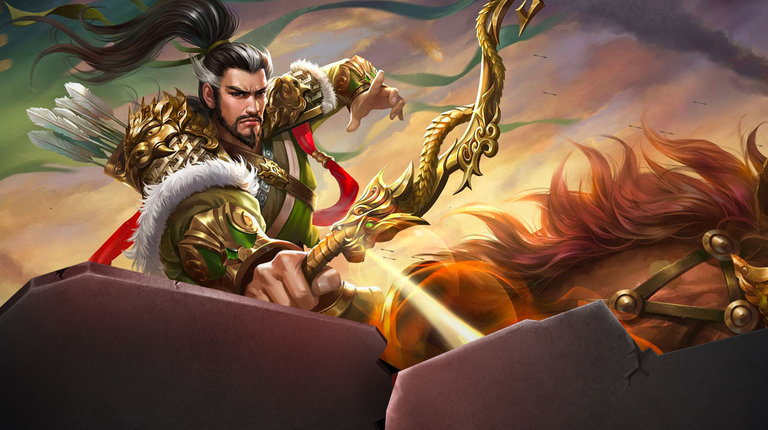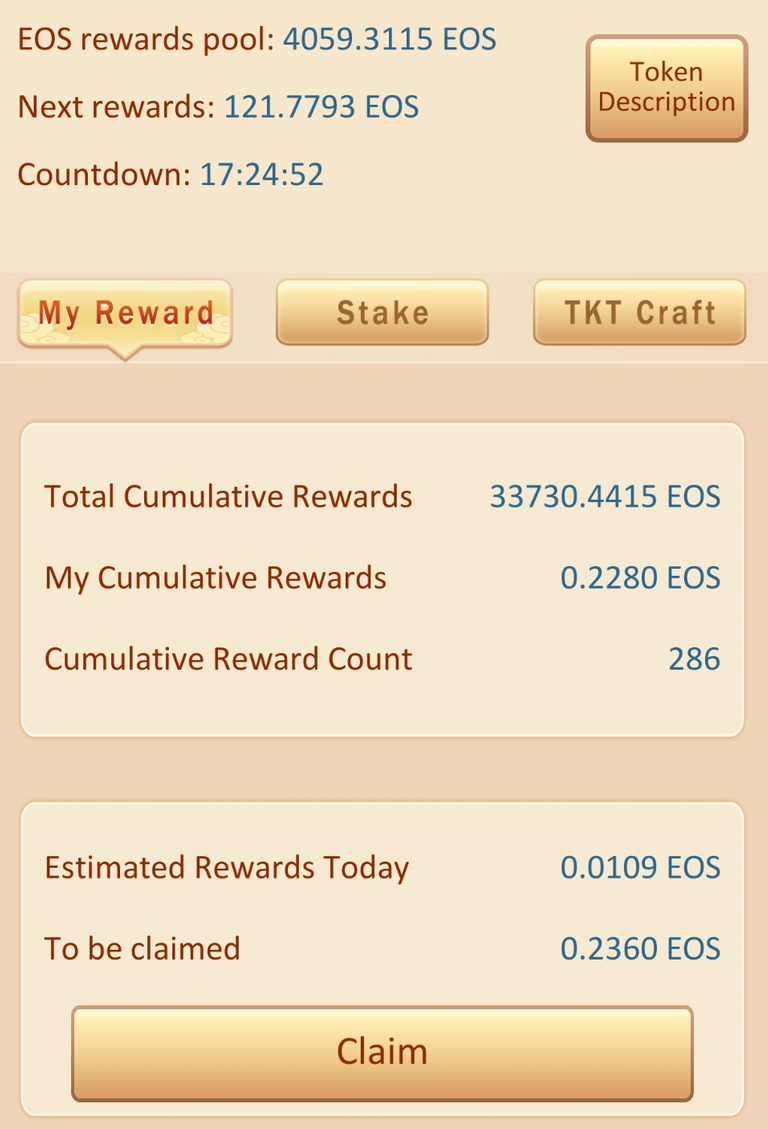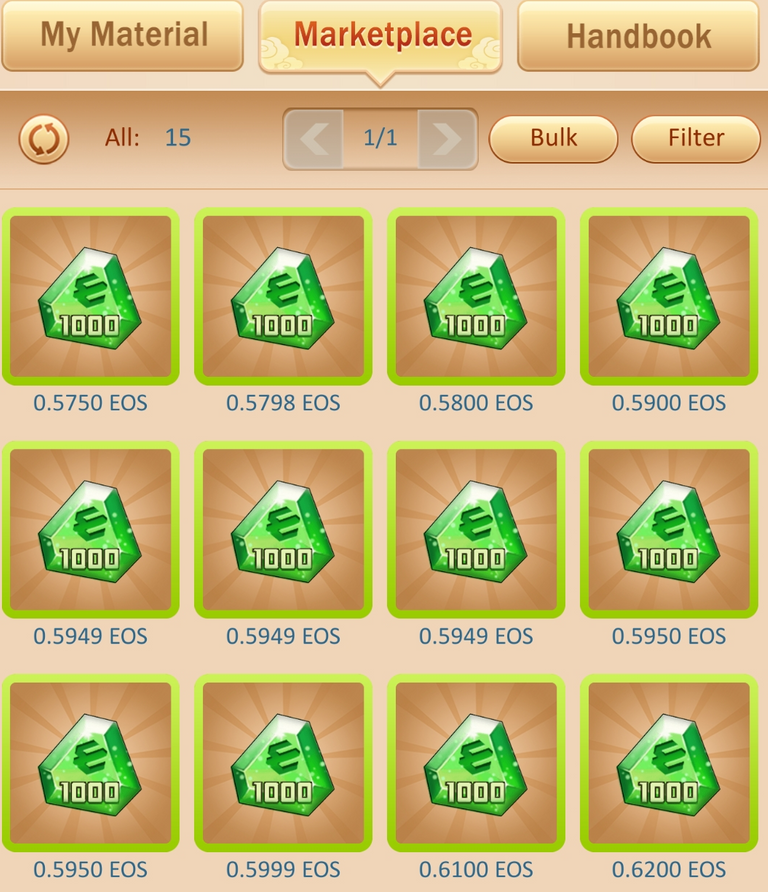
In the first part of our guide, we started off by explaining the core game mechanics of EOS Dynasty and gave some basic hints for earning some EOS in the game. In this sequel, we’re getting into the juicier parts and going over some earning, ehm, strategies.
6 ways of earning EOS
Overall, there are six ways to earn EOS from within EOS Dynasty. While they have varying dynamics, almost all follow the similar logic: the stronger your Heroes are, the more you can make. But first, let’s have a look at the different options to earn EOS:
- Sell material, equipment and items
- Stake TKT tokens
- Mining Boss rewards
- Arena Rewards
- Tasks
- Referrals
Although it depends on the overall state of the game economy, I will try to match different stages of the game with the best fitting earning options.
Selling stuff
In EOS Dynasty, there are three types of “things” that you can buy and sell - material, equipment and items.
As you can only sell three material/equipment at a time, it makes sense to lay out the “bestsellers” first. By that I mean pieces currently trading above the minimum price.
Material
Selling leftover material is the straightest way to make some extra EOS while playing. You can even sell the most basic material of the Normal grade, so you can start selling with just one low-leveled Hero, even if you won’t make much. Typically, most materials (except for Legend ones) sell close to their minimum price:
- 0.001 EOS for Normal material
- 0.005 EOS for Rare material
- 0.025 EOS for Master material
- 0.5 EOS for Epic material
- 1 EOS for Legend material
However, it’s worth checking the current lowest prices on the market for your material because some effects may drive the market price a lot, like the Forging tasks.
As I wrote in the first part, you get material every time you march and for each mount expedition. So if there’s nothing useful you can forge from them, make sure to check whether you can get a good price before melting them into Tiger Runes.
Continuously selling material on the market can provide for a small but steady income which you can reinvest into materials you actually need, stronger equipment, Tiger Rune packages, or obviously cash out or play some other game that you can find on Wombat.
Equipment
Equipment is trickier to deal with than material, and it’s generally a much broader topic. This is mainly because the equipment will vary in quality once forged, and depending on quality, prices can differ by a lot.
The general strategy here is to:
- Resell equipment that you don’t need anymore, but that’s generally high quality, or
- Forge equipment that you think might sell well
It’s hard to gauge what kind of equipment will sell the best at the time you’re reading this, so make sure you check the markets before you forge equipment and — before putting them out for sale — compare prices for equipment that has a similar percentage score. Keep in mind that attribute values affect prices as well, even for equipment with equal percentages. As a rule of thumb, the higher the grade and value of the equipment you’re selling, the more alert you should be towards the current market fares.
Sometimes, there might be arbitrage opportunities. This means that you can buy something cheaper and sell it at a higher price immediately. This might specifically occur between the material and equipment markets, where buying materials and forging equipment might be cheaper than buying the said equipment right away. Another scenario is when a higher-level set costs less than the number of individual level 1 pieces you’d need to synthesize it.
It can make sense to day-trade materials and even equipment, but I’d recommend to learn the market dynamics and the equipment demand first and watch out for the tasks.
Items
You can buy and sell most of the items: Fragments, Skill Books and Skins.
I won’t cover skins here, because they are very expensive and trading volumes are generally low.
The item system is rather simple - there are fragments of three rarities (rare, master, epic) and the respective skill books. You can craft skill books randomly from three fragments of the same kind.
You can get fragments from Arena fights in exchange for Honor you receive for every victory. Your mounts can also fetch fragments during travel (travel is similar to exploration, except that it requires tickets).
Effectively, if you don’t plan on participating in the Arena until far in the future, you can try to sell the fragments you find/win at the minimum price. If they don’t sell because of high competition, craft random skill books and sell those at market price.
Stake TKT

Staking TKT will likely be the most reliable source of income throughout your EOS Dynasty journey. At the time of writing, every 10000 TKT will provide for about a 0.005 EOS in daily rewards. The rewards depend on two factors:
- Your amount of TKT staked in comparison to the entire TKT stake
- The total revenue the game makes; a portion of the game revenue goes into a reward pool, of which 3% are distributed daily at 12:00pm UTC
This means, in order to have a steady income, you would want to accumulate as many TKT as you can.
How to get TKT
There are many ways of getting TKT:
- Spend EOS in the in-game store, e.g. on Gift Packs, Tiger Runes, inventory expansions, etc. Each EOS spent will get you about 500 TKT
- Buy material or equipment in the marketplace; this will give you 25 TKT per EOS spent
- Daily battle award: Check your Mining ranking on the March screen - once you’re reaching about 50 castles you should be receiving at least 1 TKT per day
- Weekly Boss award: Once you start participating in the boss raids, you can get some TKT simply for joining the easiest raids every time
- TKT Diamonds: The fastest way to get TKT. Buy these materials on the marketplace and redeem them for TKT. You can reverse this process and sell your TKT this way
- Tasks: Complete the tasks and make both EOS and TKT (more details below)
- Arena Ladder rewards: The top 100 Arena players get a significant amount of TKT each day. However, you will have to be fairly advanced to make it to the top 100 in the arena
In order to receive your daily rewards, you also have to stake your TKT tokens under Reward on the March screen. In addition, you need to march at least once a day to be eligible for this day’s distribution. Once distributed, you have to manually claim them.
Trade TKT

If you don’t think that TKT staking is for you, then you can sell TKT as soon as you have at least 1000 of them. Go to TKT Craft on the Reward screen, craft your material and sell it on the marketplace. At the time of writing, the price per 1000 TKT in the form of TKT Diamonds is between 0.5 and 0.6 EOS.
This means that if you want to buy TKT and stake them for profit, 10000 TKT costing a little above 5 EOS would make you 0.005 EOS per day (in investors' terms, that is roughly 0.1% per day or 30-35% on an annual basis).
Mining Boss rewards
Once you have crafted your first ticket, you can participate in the boss raids. There’s a new raid pretty much every day, and your contribution will depend on your heroes’ strength. Your performance in raids and how often you join these define the Reputation score you get for the weekly boss ranking.
Besides Reputation, you can also get extra material from boss raids. However, those materials alone will by far not replace what you’d spent to craft the entry ticket — unless you pretty much carry the raid crew.
Even if you don’t contribute all too much to the raids, consistent participation will earn you a few TKT every week. The top 100 contributors will also get EOS prizes of currently between 1.5 and 8 EOS per week, depending on the rank.
Arena rewards
Similar to the boss ranking, you can get EOS on a weekly basis for getting into the top 100 in the Arena leaderboard. The prizes here range between slightly below 1 EOS and 6 EOS per week.
In addition to the weekly EOS rewards, top rankers get TKT on a daily basis.
The Arena is a Player-vs-Player (PvP) mode inside of EOS Dynasty. The winner gets points according to an ELO-like system; the loser loses an equivalent amount of points. Each player can attack 3 times per day for free; extra attacks (Challenges) require spending Tiger Runes.
The strength of your team depends on a variety of factors, including individual attributes, skills (which you can learn from skill books instead of selling these), and formation. You will have to play around with the right skills and formations if you really want to succeed in the Arena, as this is the most advanced of the modes within EOS Dynasty.
Tasks
There are two types of tasks in EOS Dynasty - Furnace and Forge.

Both share the same basic mechanic — they require you to forge (or buy) certain equipment and submit that to the task. The equipment will be destroyed in that process.
Furnace tasks ask you to submit as many equipments of a specific kind as possible. The players who submitted the most will win. Prizes can vary but can reach 12 EOS + 4800 TKT per winner.
Forge tasks will also let you submit equipment, but with a limitation on the accepted percentage values and level. For example, it could ask you to submit a level 2 “Bow of Starry Sky Catcher” of value between 50 and 60%. If this sounds difficult, that’s right, it is. This is why every single submission will win a prize, typically at least 2-3 EOS (plus a bunch of TKT) per submitted equipment.
Both Forge and Furnace tasks typically require Epic equipment to be submitted. If you don’t find a ton of materials to forge it, you could watch the markets and buy the materials instead. There’s plenty of arbitrage opportunities, especially at the beginning of the tasks, but be aware that joining early might bear the risk of being overtaken late in the task.
Knowing of these opportunities, many people buy a lot of material needed for the tasks and will therefore drive the prices up. You can exploit this by selling as much material of the needed types as possible as tasks run.
Referrals
This is the most “boring” way of earning EOS in EOS Dynasty - ask friends to submit your EOS account name as the referrer and earn a share of the money they spend in the game. The more people you refer, the higher your share is. It can get up to 8% (marketplace transaction don’t count towards this, of course). In addition, both of you get 1000 Tiger Runes.
It’s a wrap
This is it for all the strategies on how to earn EOS by playing EOS Dynasty. In general, the game has a very steady in-game economy with stable (and growing) player numbers and marketplace prices. Of course, this might not be a good prediction for the future, so make sure you only spend a significant amount of EOS in the game if you really like to play EOS Dynasty (I do!).
Leave some comments if there are any topics that you felt I left open, I’m totally up for writing the third part if need be. Also, make sure to join our Telegram community or follow us on Twitter to never miss out on promotions and more guides and articles.
My EOS account hasn't worked for months, does anyone have the same problems?
Our EOS account do work, but there's been some issues on the EOS blockchain since November last year. Are you having trouble with low CPU?
Yes I have trouble with CPU. I don’t like EOS much more. Currently I prefer STEEM blockchain. I Hope EOS blockchain will be better next year